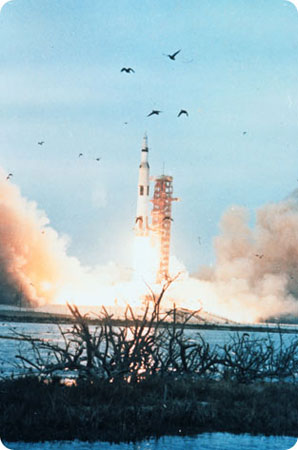In the summer of 2007, bright searchlights were helping engineers get space shuttle Endeavour ready for its next trip to space. But just a few hundred yards away, the lights were bad news.
 Wildlife habitat near Cape Canaveral. Credit: National Oceanic and Atmospheric Administration
Wildlife habitat near Cape Canaveral. Credit: National Oceanic and Atmospheric AdministrationIt was nesting season for several species of sea turtles. Bright lights can scare away females before they lay their eggs, or cause the hatchlings to run toward land instead of the ocean. Tall dunes just behind the beach normally screen out the light, but hurricanes had lopped off their tops. So NASA parked railroad cars behind the lowest dunes, blocking the light and allowing the turtles to go about their business unharmed.
This episode shows that while the area around Cape Canaveral is best known for the roar of rocket engines, it’s also home to one of the most vibrant marine habitats in the country.
Just north of the Cape, for example, a national seashore protects a skinny barrier island that has the longest undeveloped beach in Florida. Pompano, bluefish, and red drum swim offshore in the Atlantic, while hundreds more species of fish congregate in Mosquito Lagoon behind the island.
The lagoon also offers extensive seagrass beds, and big reefs of Eastern oysters. The lagoon and a couple of nearby rivers are home to manatees and dolphins. And much of the adjacent Merritt Island, where the shuttles are launched, is covered with mangrove forests. These thickets provide habitat for many species of birds, fish, and shellfish -- all living in the spotlight of the space program.

